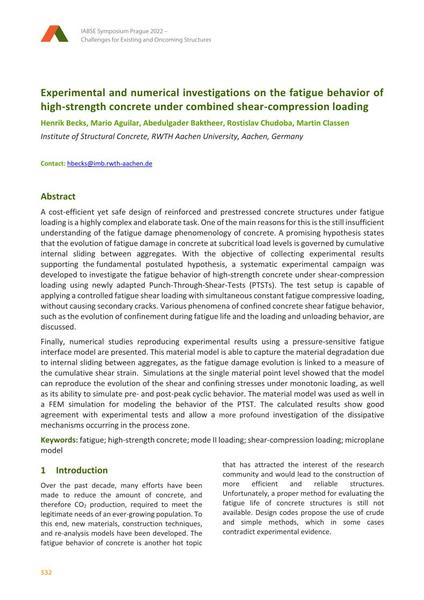Experimental and numerical investigations on the fatigue behavior of high-strength concrete under combined shear-compression loading

|
|
|||||||||||
Bibliographic Details
| Author(s): |
Henrik Becks
(Institute of Structural Concrete, RWTH Aachen University, Aachen, Germany)
Mario Aguilar (Institute of Structural Concrete, RWTH Aachen University, Aachen, Germany) Abedulgader Baktheer (Institute of Structural Concrete, RWTH Aachen University, Aachen, Germany) Rostislav Chudoba (Institute of Structural Concrete, RWTH Aachen University, Aachen, Germany) Martin Claßen (Institute of Structural Concrete, RWTH Aachen University, Aachen, Germany) |
||||
|---|---|---|---|---|---|
| Medium: | conference paper | ||||
| Language(s): | English | ||||
| Conference: | IABSE Symposium: Challenges for Existing and Oncoming Structures, Prague, Czech Republic, 25-27 May 2022 | ||||
| Published in: | IABSE Symposium Prague 2022 | ||||
|
|||||
| Page(s): | 532-540 | ||||
| Total no. of pages: | 9 | ||||
| DOI: | 10.2749/prague.2022.0532 | ||||
| Abstract: |
A cost-efficient yet safe design of reinforced and prestressed concrete structures under fatigue loading is a highly complex and elaborate task. One of the main reasons for this is the still insufficient understanding of the fatigue damage phenomenology of concrete. A promising hypothesis states that the evolution of fatigue damage in concrete at subcritical load levels is governed by cumulative internal sliding between aggregates. With the objective of collecting experimental results supporting the fundamental postulated hypothesis, a systematic experimental campaign was developed to investigate the fatigue behavior of high-strength concrete under shear-compression loading using newly adapted Punch-Through-Shear-Tests (PTSTs). The test setup is capable of applying a controlled fatigue shear loading with simultaneous constant fatigue compressive loading, without causing secondary cracks. Various phenomena of confined concrete shear fatigue behavior, such as the evolution of confinement during fatigue life and the loading and unloading behavior, are discussed. Finally, numerical studies reproducing experimental results using a pressure-sensitive fatigue interface model are presented. This material model is able to capture the material degradation due to internal sliding between aggregates, as the fatigue damage evolution is linked to a measure of the cumulative shear strain. Simulations at the single material point level showed that the model can reproduce the evolution of the shear and confining stresses under monotonic loading, as well as its ability to simulate pre- and post-peak cyclic behavior. The material model was used as well in a FEM simulation for modeling the behavior of the PTST. The calculated results show good agreement with experimental tests and allow a more profound investigation of the dissipative mechanisms occurring in the process zone. |
||||
| Keywords: |
fatigue high-strength concrete shear-compression loading mode II loading microplane model
|
||||
| Copyright: | © 2022 International Association for Bridge and Structural Engineering (IABSE) | ||||
| License: | This creative work is copyrighted material and may not be used without explicit approval by the author and/or copyright owner. |
||||
